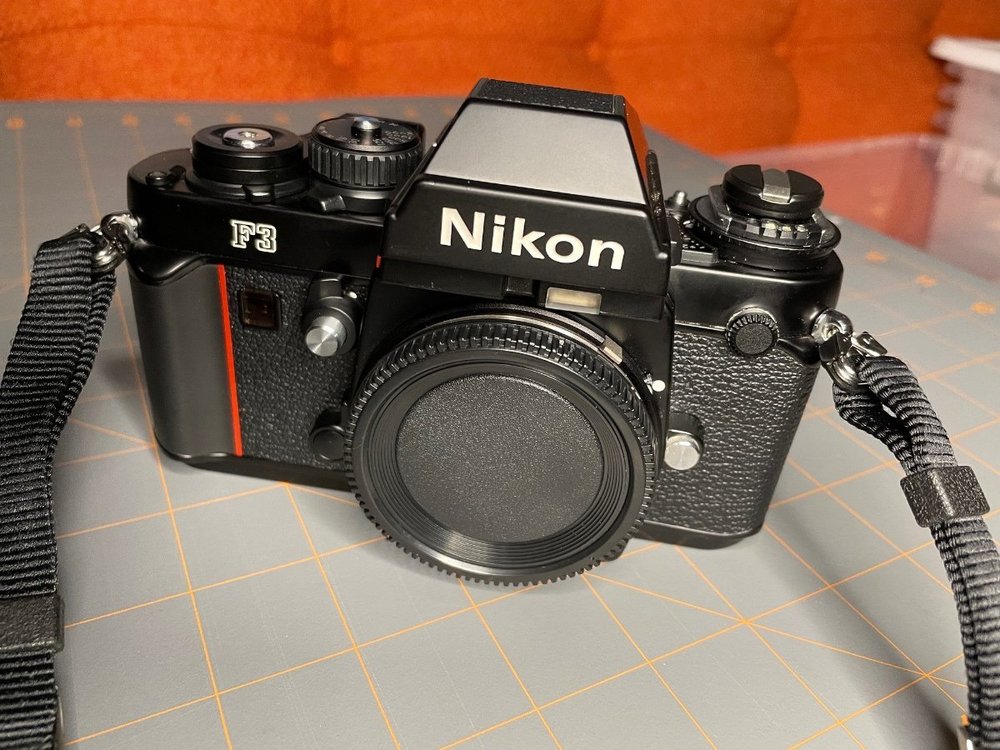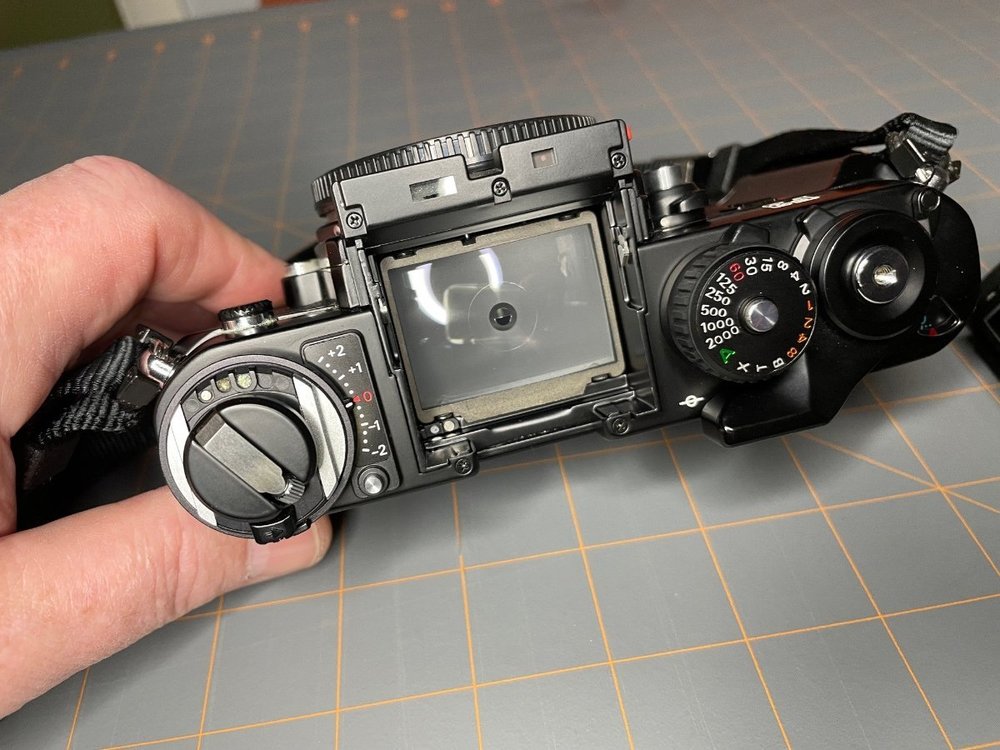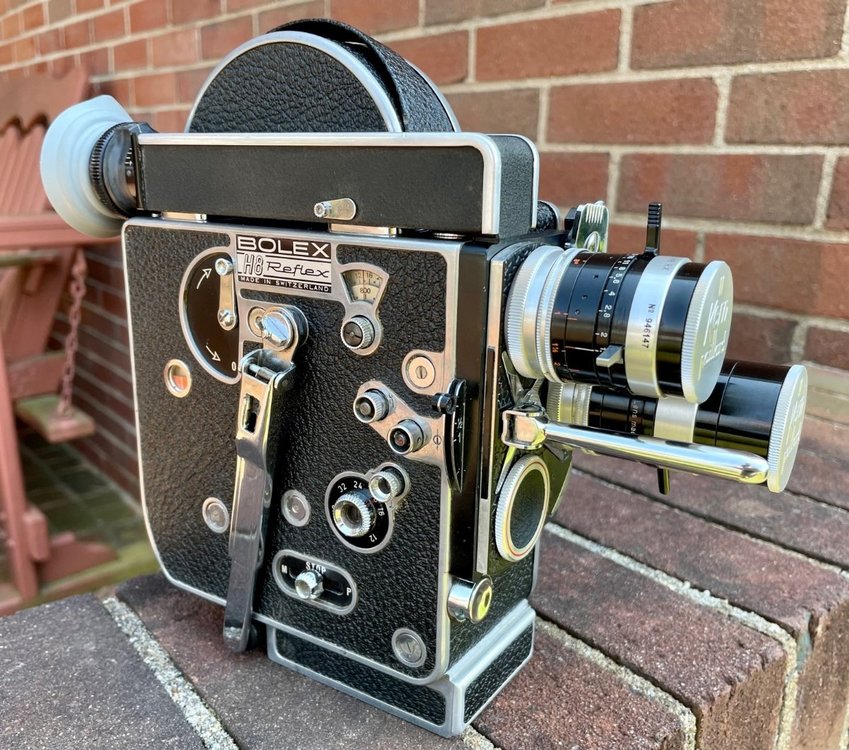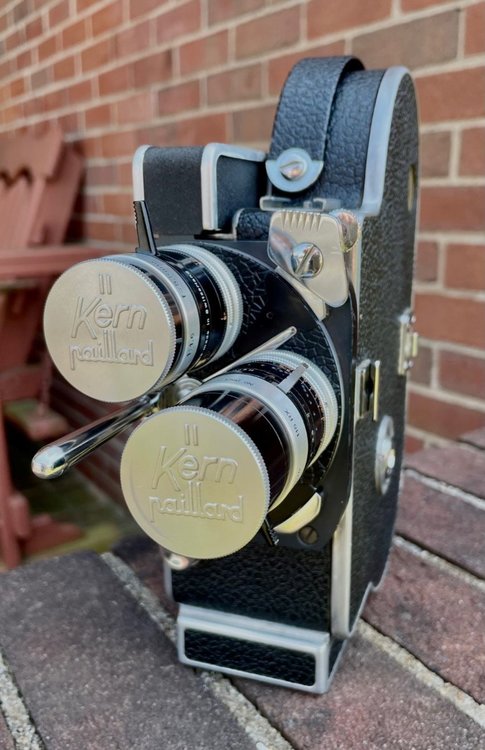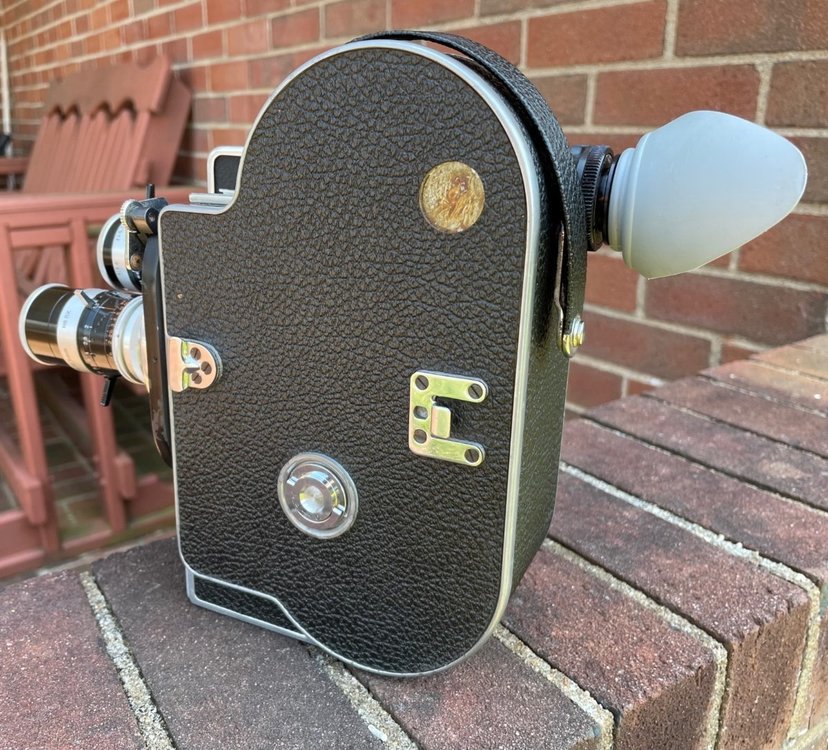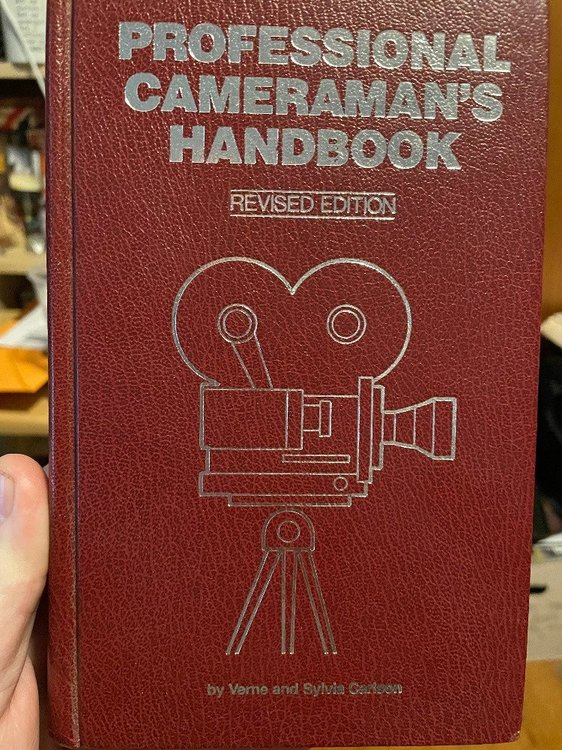-
Posts
521 -
Joined
-
Last visited
Everything posted by Frank Wylie
-

Why is this sound so bad with a Lasergraphics scanner?
Frank Wylie replied to Daniel D. Teoli Jr.'s topic in Post Production
I'll just make a few clarifications on my statements and then leave this thread alone; I don't have a horse in this race anyway. As to the distortion being built into the mix, I stand by that possibility. Industrial/Classroom film making was a huge industry with intense pressure to produce product at a reasonable price point, so standards were sometimes rather lax by necessity. Added to this, the propensity for exactitude in presentation and audience critical response is now orders of magnitude ABOVE what a typical client/sponsor/viewer had in the era in which the film was made. Digital delivery and exhibition has (IMHO) both spoiled and given modern audiences an unrealistic expectation of just how mainstream industrial media was produced and consumed. This why I brought up the point about poorly serviced 16mm projectors. The producers/clients knew where their material would eventually wind up be exhibited and they factored that into their thought process. it wasn't desired, but some slippage could be tolerated to finish the project. The standards for production were never intended to be poor, it's just that I think that when push-came-to-shove, a budget-stressed client would overlook a lot of problems that would be considered a deal breaker now. Remixing a track in a physical dubber system that could cost a thousand dollars an hour (1960/70's dollars mind you) could blow an entire budget. Anyone who has recorded a sustained piano note on non-digital equipment knows it is one of the most severe tests of transport stability an analog recorder can face. As to the statement that implied that I ran a junky, unserviced mixing system; you don't know what you are talking about and probably only have experience with stand-alone mag transport units. Selsyn systems are physically interlocked and have resonances that can be communicated back through the drive shafts to the system as a whole. So, unless you take super critical care in editing your mag fullcoat, any other track that has a poorly made splice can send a ripple back through the system and cause speed distortions on other dubbers. Also, I would like to point out that the narration COULD have equal distortion, but you probably will NOT hear it unless the person breaks into song; then you would hear it. Anyway, believe it or don't: I could really care less.- 52 replies
-
- 4
-

-

-
- scanning film
- lasergraphics
-
(and 1 more)
Tagged with:
-

Why is this sound so bad with a Lasergraphics scanner?
Frank Wylie replied to Daniel D. Teoli Jr.'s topic in Post Production
The wow and flutter is most likely built into the stems of the pre-master mix and simply not worried about. Understand that these industrial films were churned-out by the mile from the late 40's to the late 1970's and were understood to be played back on classroom 16mm projectors. Most of these projectors were lucky to even be cleaned, let alone serviced in their entire operational lives. Most library music of the period came on either 78 or 33 rpm LPs and simply transferred to mag fullcoat without a lot of worry; it was wild sound, not sync. I ran an 8 dubber Magnasync Selsyn Interlocked mixing system for 16mm sound mixes at Ohio State University and if you did not attach at least 30 to 40 feet of leader to the head of the mix, you could not be assured it would be totally stable by the time the sync pop hit the heads. There are a lot of reasons the music could have wow and flutter, but not the narration...- 52 replies
-
- 2
-

-
- scanning film
- lasergraphics
-
(and 1 more)
Tagged with:
-

Jobo 3016 Drum: B&W Reversal Processing
Frank Wylie replied to Don H Marks's topic in Film Stocks & Processing
Build a drying wheel. Easiest way is to take to large diameter bicycle rims and bolt marine grade urethane-finished hardwood slats (or 1/2 inch PVC pipe) between the rims. (Think paddle wheel steamer, but with the flat faces toward the rim) Punch a hole in the head of the film, attach it to a slat and wind the film emulsion out around the slatted drum in a spiraling fashion while applying a bit of diluted photoflo to the film with a chamois or soft cloth. When you reach the end, punch another hole and place rubber bands through the hole and clamp them to a slat that provides some tension, but not high tension. Give the wheel a good spin to fling off the water/photoflo and let it dry. Bonus points if you use a rear rim on one side and chain drive a slow ac motor to allow it to rotate slowly as it dries. Congratulations; you're in the Silent Era. As for slitters, many are available on Ebay; they were part of the Lomo tank kit for 35/16 development.- 1 reply
-
- 1
-

-
From what I understand, the software is locked to the CPU by an algorithm that computes a unique identifier based on some fixed value in the CPU. Even if you manage to somehow copy the software, it will only run on the original CPU upon which it was installed. I was told by one owner that If your CPU dies, then their usual solution is to install a completely new computer rather than just swap out components. Take it for what it's worth; hearsay...
- 13 replies
-
- 1
-

-
- scanner
- lasergraphics
-
(and 2 more)
Tagged with:
-

What is this film used for?
Frank Wylie replied to Daniel D. Teoli Jr.'s topic in Film Stocks & Processing
Flutter testing was important to in-camera optical sound recording as well as sound playback projection. Flutter was induced by the difference between the intermittent motion of the film in the camera/projector gate and the continuous motion of optical sound readers/recorders. The test films were designed to measure the amplitude of fluctuations present in the optical pickup after the camera/projector gate and allow engineers/technicians to fine-tune the transport to minimize this audio problem. -

What is this film used for?
Frank Wylie replied to Daniel D. Teoli Jr.'s topic in Film Stocks & Processing
All original Super 8mm and Regular 8mm test materials (negatives, interpositives, etc.) for Super 8mm and Regular 8mm were donated to the Library of Congress Motion Picture Lab in Dayton, Ohio when I was Lab Supervisor in about 2003/2004. I had called to inquire about getting new RP40 optical printing alignment targets for our production, when I was informed that SMPTE had discontinued producing those materials and were only selling what remaining stock on-hand. (We wound up duplicating our own RP40 masters from a small roll I found buried in a back storage room) Somehow the conversation got around to S8/R8 when they informed me they were about to discard those elements. I suggested they donate them to the LOC and they did. They now reside somewhere in the collections in Mount Pony at the National Audio Visual Conservation Center in Culpeper, Virginia. I have since retired and don't know their status. Hopefully, they have been ingested and are in archival storage. I do not recall if there were 9.5mm elements, but I don't think so... -

What is this film used for?
Frank Wylie replied to Daniel D. Teoli Jr.'s topic in Film Stocks & Processing
https://www.sprocketschool.org/w/images/3/38/Smpte-test-materials-catalog.pdf -
Sorry, I couldn't resist. Not mine, can't vouch for it or the seller, thought someone on here might have an interest in this #2 serial number camera. Better have a machine shop, three assistants and an incredible tripod when you take this camera for a spin... https://www.ebay.com/itm/326013146829?mkcid=16&mkevt=1&mkrid=711-127632-2357-0&ssspo=yTc_-1ywTF-&sssrc=2047675&ssuid=gZKdZ7m3Rw-&widget_ver=artemis&media=COPY
-

Cinematography.com's David Mullen wins ASC award
Frank Wylie replied to Jeff Bernstein's topic in General Discussion
Congratulations! -
Nikon F3 body with DE-2 Standard Viewfinder in extremely clean, but used condition. I am reluctantly parting with this camera body because I have an F3 in lesser condition that works just fine; no need for duplication, no matter the shape!. As per title, I will sell this body for $325 + $20 to be shipped and insured within the Continental US. All other buyers outside the CONUS, inquire for shipping rate. Comes with body cap and nice nylon strap. Batteries will be removed prior to shipping. Other than a few dust specs in the viewfinder (and those can be removed with some careful cleaning), I can find no fault with the camera. Look carefully at the photos, as this camera has a brand new set of light seals from Jon Goodman; all seals in the back and in the viewfinder have been replaced. You may return this camera within 5 days if you are not 100% satisfied; camera must be in identical shape and return shipping/insurance will be at your cost, as with most typical online sales. PM with questions, if any. Due to file size limits on this site, PM me for more photos. Camera will be advertised on other sites.
-
Now that I have retired, it is time to rationalize my camera holdings. I can no longer justify just sitting on a good camera as a display piece when others can be shooting with it and having fun. I am selling my Bolex H8 Reflex for what I have invested in it and will be plowing those proceeds back into a series of large format still cameras; something I can reasonably do in my old age! Here are the particulars: 1965 Bolex H8 Reflex #212222 (see http://www.bolexcollector.com/articles/07_05_11.html) Camera is in good physical condition with few obvious cosmetic defects; a tiny bit of flaking on the viewfinder tube and the Bolex logo is missing on the camera door. Original, numbered 100 foot take-up spool included and in good shape. (numbered 1 and 2 for when you flip the film over to shoot the other side). Yes, this camera can shoot 100 feet of Double Regular 8mm film in addition to the typical 25 foot loads. The camera will run smoothly about 47 seconds on a full wind (empty) at 18 fps. The viewfinder diopter is very stiff, but adjustable. Reflex viewing is clear; very little dust (if any). Adjustable shutter works well and can totally fade-out the image as you run. Rubber eye cup is like new. Has the flat, square base built-in, but does not have the threaded holes for a matte box. That can be modified with the required parts (not included). Kern Palliard H8 RX 5.5mm f1.6 prime lens with original lens cap. Glass is generally clean and clear. There is a tiny bit of black paint flaking on an interior baffle that should not affect shooting and does not show up as floating particles, but I did want to point that out. The focus ring is somewhat stiff, but should loosen up once being used regularly. Preset f-stop levers work properly. Kern Palliard H8 RX 12.5mm f1.3 prime lens with original lens cap and lens hood. Glass is generally clean and clear. No evidence of internal paint flaking. Preset f-stop levers work properly. 1 (one) lens turret cap (non-locking) This camera can take optional (not included) Rex-O-Faders, electric motors and other Rex related accessories. Please investigate on the Bolex Collector website for more information. Remember, this camera requires the use of H8 RX lenses which are increasingly rare and expensive. The pair on this camera could sell for 2X the selling price of the entire outfit, but I don't want to be that guy or sit on the camera for months waiting for the right person to come along. I would rather the camera actually be used and enjoyed by a budding filmmaker. Shipping will be actual cost with insurance to protect you and me. The camera may be advertised on other sites, so be aware of this. If you have any further questions, please PM me. I can show additional photos if needed. Please be patient if I do not respond immediately; I will answer inquiries in the order received. NOTE: the camera has not be professional serviced since I have owned it, but it does run smoothly. Thank you.
-

Diffusion behind the lens - any drawbacks?
Frank Wylie replied to George A's topic in Lenses & Lens Accessories
From what I remember: 1. Any dust or fibers on the lens will substantially impact the image, as it is closer to the film plane. 2. Filter thickness may impact focus at infinity. 3. Spectral highlights may act differently. 4. Easy to forget it's on the lens. -

New to the ACL II and need help loading in the 400-ft mag
Frank Wylie replied to Skyler Carrico's topic in Eclair
Skyler and Gregg, Ah, I see. Sorry to have muddied the waters! Good luck finding a solution... -
Cinema began as an Artisanal, hand-crafted process. As corporations began to scale-up production for the sake of pure profit did the bulk of processes begin the gradual but incessant march away from Artisanal to mechanized production. Pathe, Lumiere and Griffith gave way to the industrialized Ince, Paramount and Fox; hand processed silent films gave way to machine processed sound film and so on. I find it humorous that those who can purchase the required equipment to make a 8/12K feature film for less than the price of a car, feel threatened by someone processing their film by hand in coffee enough to call them a "hipster"!
-

New to the ACL II and need help loading in the 400-ft mag
Frank Wylie replied to Skyler Carrico's topic in Eclair
See this from Verne and Sylvia Carlson's "Professional Cameraman's Handbook" (get a copy, they are cheap): This book makes no distinction between the 200 and 400 foot magazines, and it's been a LONG time since I handled an ACL, so there may be variations on the types of magazines of which I am unaware. However, I would think this general area of the magazine would remain pretty much unchanged, but... -
http://www.bolexcollector.com/cameras/h16rex3.html The Rex 3, unless it was modified to take a 400' motorized magazine, takes 100' daylight spools. There were factory and after market mods that would install the 400' magazine, but unless it has the saddle installed, you are limited to 100" loads. This is just my opinion, but take the crazy amount of money used to convert a camera to Super 16mm and have a simple viewfinder mask at the same aspect ratio installed. Then take the bundle of money left over and buy enough film to shoot a good sized project. When you have it scanned, you can hard matte the image anywhere in the full 16mm frame. This obsession with Super 16mm is baffling to me. Sure, back in the early 1980's when the format came out, it was a good alternative to shooting 35mm because the infrastructure and resources to do blow-ups at a relatively reasonable cost was in place. Not there anymore! With the quality of modern 16mm color negative stocks PLUS the virtual inability to obtain a S16 to 35mm blowup (both in lab availability AND in staggering cost) makes the cost of conversion and use highly questionable. Yes, you do get a very small increase in image quality, but at what cost? You can wind up with a super 16mm camera that is beautiful and no money to shoot. If you absolutely MUST have a Super 16mm camera, buy one already converted and proven to work properly. The money you save in buying a proven camera will be substantial compared to possibly having a botched conversion and no camera. Having never been independently wealthy, I never had the luxury to debate the issue.
-

Auricon user group open to all - 16mm film as well as optical sound
Frank Wylie replied to James Honeycutt's topic in 16mm
Jack Very nice. I have some Auricon literature and many photos of the many Auricon cameras I have owned over the years, so I hope to post some material on the users group in the future. Frank -
Personally, I tend to use VERY SPARINGLY a 50/50 mix of clear sewing machine oil and Marvel Mystery Oil on totally mechanical cameras. Take great care to wipe away any residual oils in the film chamber with a solvent. You don't want to get it on your film or film path. That ruins the roll and the lab will hang you from the nearest lamp post.
-
Andrew, A light weight mineral oil is generally acceptable, but don't over do it. See this operator's manual in D.D. Teoli Jr.'s archive: https://archive.org/details/filmo-70-manual-d.-d.-teoli-jr.-a.-c./page/n13/mode/2up Here's another general use manual: http://vintagecameras.fr/images/MonSite/BELL-HOWELL/Filmo_70DR/_doc/prod_manual-filmo.pdf Charles beat me to the punch on the lenses, only be aware that SOME very early TV c-mount lenses have a different back focus and may not focus to infinity. In general, I try to avoid any lens marked "TV" for that reason...
-
John Bailey was a great cinematographer and a great human being. I had the great privilege of meeting and speaking with him on a visit he paid to the LOC NAVCC in 2017. It was a shock to hear of his passing. Godspeed John.
-

earliest nighttime shots film history
Frank Wylie replied to Costanza Julia Bani's topic in General Discussion
Cannot say he was the first, but here is an early example by Edwin S. Porter in 1901 of the Pan-American Exposition for Thomas Edison. https://www.loc.gov/item/00694344/ -
With such sparse information, I can only take a stab in the dark. Perhaps the Morgana Process? https://filmcolors.org/timeline-entry/1259/#/infobox/37170
-

Looking for someone to make a 16mm/Super 8 processing machine
Frank Wylie replied to Jack Jin's topic in 16mm
Your choices are really limited, but in addition to the above person, you should at least speak to Photomec in the UK. http://www.photomec.co.uk/ As far as I know, they are the sole producer of modern film processors from S8 to 35mm. I toured their facility in 2000 and was very impressed with their dedication and build quality. They were miles ahead of other (then operational) major film processing equipment companies in implementing new technology and offering new designs.




